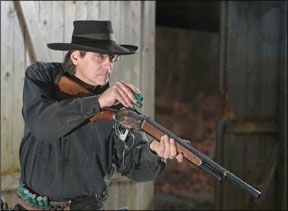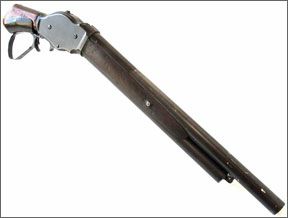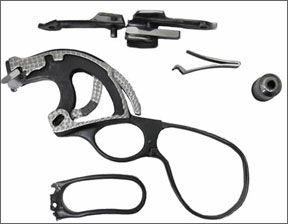Gun Tests has been independently reviewing firearms since 1989. This website contains many older reviews. Unless otherwise noted, these reviews carry the guns’ prices at the time of the original review.
It is an odd sensation to work through the various levels of the first-person shooter game Call of Duty: Modern Warfare 2 and pick up a virtual gun that hasn’t seen widespread availability in around a century. That gun is the Winchester Model 1887, a lever-action shotgun originally designed by John Browning and produced by the Winchester Repeating Arms Company during the late 19th and early 20th centuries. The www.callofduty.wikia.com site says of the ancient firepower, “The Model 1887 originally used black powder 12-gauge shells and 10-gauge shells, but replicas made today are often chambered for more common modern ammunition.” Further, the site notes that, “The Model 1887 is the only lever-action gun to ever be featured in a Call of Duty game.”

Well, yes, because the design isn’t a popular choice for shotguns, with semiautos, pumps, and double-barrels being more popular products. But the infatuation with the 1887 lever shotgun doesn’t stop there.
In Terminator 2: Judgment Day (a 1991 sequel to Jim Cameron’s original film, Terminator), a Terminator (Arnold Schwarzenegger) T-800 cyborg is sent back in time to protect Sarah Connor (Linda Hamilton) and son John Conner (Edward Furlong) from the more advanced T-1000 Terminator (Robert Patrick).
Probably the most recognizable weapon carried by Terminator Schwarzenneger is the highly customized 12-gauge 1887 Winchester lever-action shotgun. The character is seen holding this weapon (atop his Harley Davidson motorcycle) on the one-sheet posters and key publicity material. The movie gun was customized with a variety of lever handles used, such as the loop style for “swing-cocking” on the Harley Davidson.

Also, Brendan Fraser used a cut-down pistol-gripped Norinco copy of the Winchester 1887 in The Mummy Returns, most notably in the bus scene.
We understand the use of the 1887 in the Mummy movies—they’re period pieces, and the 1887 fits. The initial runs of 1887s were made by Winchester in New Haven, Connecticut. They are notable for a small hammer spur at the top of the action, a solid lever, and a ball-type pistol grip on the buttstock. Most had fluid steel barrels, though some had Damascus steel and were only safe to use blackpowder. They were made from 1887 to 1901, about 65,000 in all.
Coming back to current times—in a way—the 1887 is widely used in Cowboy Action events, but perhaps most fluently by SASS champion “Gunfighter” Lassiter, aka Tom Wildenauer. Starting with an open action, he’s able to load two and shoot two in under 3 seconds. Not bad for a design that few have seen and fewer have shot.
So, with all this interest in the 1887, we wanted to compare a couple of current production models to see which one we’d buy for fun shooting. Our test guns were the IAC Imports Reproduction Cowboy 1887 87W-1 lever action, $600; and the Armi Chiappa 1887 Fast Load 930.004, which we found selling under the Puma name by Legacy Sports International for $1229. Both guns have 12-gauge barrels chambered for 2.75-inch modern shells. The IAC has a 20-inch barrel with a fixed Cylinder choke and a five-round-capacity tubular magazine. The Chiappa we tested had a 22-inch barrel and was threaded for choke tubes and and came with a Cylinder screw-in tube. It had a total capacity of two because of an action modification that speeds reloads for CAS at the expense of total round count.
Here’s what we thought of them:
Legacy Sports International Puma PCH87003 2.75-Inch 12-Gauge Lever Action, $1229 (Armi Chiappa 1887 Fast Load No. 930.004)
Fifty-two years ago Armi Sport, the foundation of the Chiappa Firearms group, began making replica products. In 1958, the company first made a Corsair Pistol, followed by a Kentucky pistol (1962), Kentucky rifle (1963), then several other products before the 2008 introduction of the 1887 lever-action shotgun.
Armi now makes six versions of the lever shotgun, three with color-casehardened receivers and three chromed receivers. Legacy International catalogs three of the 1887-style shotguns, two of which don’t have the Fast Load feature. The PCH87003 unit has a 22-inch barrel ($1239), and the PCH87002 issue has a 28-inch barrel ($1269). All three guns have color-casehardened receivers and blued-steel barrels and other metalwork.
Many of the physical details of the Armi shotgun conform to dimensions you’d expect from a self-defense shotgun. It has a fairly short 39-inch overall length and a fast-pointing 22-inch barrel. Length of pull is a surprisingly short 12.6 inches, for reasons we’ll detail below, and 2 inches of drop at the comb and 2.2 inches of drop at the heel. There’s a lot of pitch, -3.0 inches, and no cast in the stock that we could see. That the gun lacks cast is important for lefties, since we found the lever could be cycled equally well from either side, and ejection occurs out the top of the action.
The gun is heavy at 8.4 pounds, the result of a thick-walled barrel and a massive steel receiver and steel action parts. The receiver and steel buttplate are color-casehardened in finish, set off by the barrel and under-barrel tubular magazine, which had a rich blued finish. We didn’t detect any blems in the metalwork, except for the natural variations of the casehardened coloring.
The gun lacks an external safety, which would be out of phase with the 1887’s lineage, of course. But it includes a breech block safety that keeps the gun from firing unless the action is fully closed and the trigger is pulled. Using a Lyman digital trigger-pull gauge from Brownells, we measured the trigger-pull weight at a crisp 3.2 pounds—better than many modern shotguns we’ve tested over the years.
The furniture, like the metal, was nicely executed. The walnut buttstock wood was matte finished, which showed a medium grain underneath a fairly dark stain. The fore end panels were a little lighter, especially the left-side one, so they didn’t match the buttstock tone that well. But the fore end panels were attached with pillars going sideways through the stock, so that the screws that attached the panels wouldn’t crack the thin panels.

Considering these points, the team’s just-out-of-the-box view of the Chiappa was very positive, and when we burrowed down to the details, we became even more impressed. The inset cut where the top of the steel buttplate joined the butt was tight, as was the fitting between the rest of the buttplate and buttstock. The tang was likewise fitted well, though not quite as tightly as the buttstock joint. The bottom fit was better than the top, but our testers weren’t offended by the quality of work anywhere. The fore end panels fit tightly against the receiver, and the joints between the fore end panels and the tube and barrel were snug as well.
Yes, yes, you say, that’s all very nice. Pretty. Yay! But how does it shoot? Handling the Armi and Norinco lever guns is an acquired taste, our team said. When the gun comes up to the shooter’s eye, he sees a 0.15-inch-wide brass front bead through a shallow scoop in the top of the receiver. During the mount, the inclination is to bring the front hand back toward the receiver to force the gun to stay in the shoulder pocket. The steel buttplate is slick, and the force necessary to pull the lever open—according to the Lyman gauge, about 4 pounds with the hammer down (uncocked) and 10 pounds with the hammer back (cocked)—can also pull the buttstock off the shooter’s shoulder.
The natural response to this downward movement is to pull the front hand back toward the receiver to control the middle of the gun. But this doesn’t work because the cycling lever will hit the front hand if the hand is too close to the receiver. Fully opened, the lever pushed about 10 degrees forward of perpendicular to the boreline, so the front thumb needs to sit on the rear panel screw to ensure the front hand clears the lever travel.
Getting the mount right is vital in shooting any shotgun, of course, because the eye needs to naturally sit on the buttstock and see the top of the barrel. But getting the mount right is even more important when you shoot these guns because if you don’t get the buttstock in the shoulder pocket, it will kick the crap out of you. The steel buttplate is unforgiving, but the toe is particularly brutish. Put the gun up half an inch off, and all that recoil gets focused on about one square inch of pointy steel pressed into your pectoral, deltoid, or biceps muscle, depending on how and which way you miss the mount.
But with a firm mount, the shooter who is running the Armi can have a lot of fun. If you’re plinking and don’t have to worry about capacity, just fill the gun up and start hulling—it’s a kick to fire the Chiappa and hear the schlockety-schlock of the steel action moving shotshells right below your face. With much of the mass in the middle of the gun, it balances well (at the front of the receiver). The large amount of pitch in the buttstock allows the shooter to comfortably keep an erect head without having to push the gun up. This allows the shooter to likewise keep an erect posture and shoot comfortably without having to push the shoulders forward.
We liked the Chiappa’s two-shell-load feature, which the Norinco wouldn’t do. To use the feature in CAS competition, the shooter starts with an empty gun on a table. On the audible start, he picks the gun up and mounts it to his face. The trigger hand (as we noted, the gun is ambidextrous) flicks the lever open, then moves to a shotshell belly bandolier, grabs two shells in a stacked grip, and drops them simultaneously in the top of the gun. He then closes the lever, shoots once, then cycles the lever and shoots the second shell, all the while keeping the gun mounted. It is faster to do than write.
Our Team Said: We hate to say that this matchup was over before the shooting began, but it very nearly was. The Legacy gun was gorgeous. Everywhere we examined it, it smited the Norinco on cosmetics, fit, and finish. It also cycled flawlessly from the magazine, which the Norinco didn’t do. Still, we have reservations. The antiquated loading system is a hassle, despite its charm. We’d much rather have a Winchester 9410. And if you plan to shoot it much, you should add a gel buttpad. Also, it is twice the money of the Norinco, but sometimes you get what you pay for.
IAC Imports Reproduction Cowboy 1887 87W-1 lever action, $600
IAC Imports is a division of Interstate Arms Corp (Billerica, Massachusetts), which imports reproductions of classic firearms. Regarding the 1887 shotgun, IAC puts this note high up on its website: “The original John Browning 1887 lever-action shotgun was designed for blackpowder. Later, it was re-designed for smokeless powder but was only available in 10 gauge. In order to faithfully reproduce this classic, IAC engineers had to incorporate the improvements from the 10-gauge gun into the earlier 12-gauge frame. Rockwell testing for strength and durability confirmed our success.”
We have no problem with making changes needed to produce a 12-gauge reproduction strong enough to accept smokeless powders, and we applaud IAC’s ingenuity in getting that done. And we understand the value of putting a gun at a price point that people can afford, and the Norinco-built IAC product accomplishes those goals.

The basics on the two guns are much the same. The Norinco has a short 37-inch overall length and a 20-inch barrel. It was also half a pound lighter unloaded (7.9 pounds). With six shells on board, however, the curb weight went to 8.6 pounds. LOP was 13.2 inches, half an inch longer than the Chiappa, with a little more drop at comb (2.4 inches)and drop at heel (2.8 inches). There was less pitch, -2.2 inches, and no cast. We measured the trigger-pull weight at a superb 2.9 pounds. We were amazed at the trigger quality in these guns.
All the external metal parts were matte-black steel, and the gun was nicely finished. The black steel didn’t present as well cosmetically as the casehardened receiver, buttplate, and barrel band on the Chiappa, our team averred.
The wood pieces were executed adequately. The walnut buttstock grain showed well, we thought, with interesting colors in the sides. The fore end panels matched the buttstock tone better than the Chiappa, we thought. The fore end panels also had screw sleeves (black) to protect the thin panel wood.
But when we examined the gun closely, we noticed what we deemed a lower assembly quality. Thought the IAC’s plastic buttplate was perfectly fitted to the buttstock wood and the tang fit was better than the Chiappa’s, the ball pistol grip looked rudely cut. Also, there were 0.2-inch gaps between the fore end panels and the receiver.
At this point, however, these fit-and-finish issues could be overlooked because of the hundreds of dollars separating the two guns. But the IAC faltered at the range, to our great disappointment.
Cycling the gun was problematic. Though the split-lever system allowed the action to open more easily at the start, our testers had a lot of trouble working the action vigorously enough to extract the shells. Mid-stroke, the mechanism seemed to catch, and it required an additional push forward on the lever to get going again. Then, at the end of the eject stroke, the shooter had to snap the lever forward to get shells to clear the top of the receiver, which they only sometimes did. Shooters with shorter arms and women had even more trouble. Naturally, this led to rounds stovepiping in the receiver and necessitating tipping the gun to shake them out. We re-oiled the action and cycled it more than 500 times to shake out the problem, but it persisted.
We also noticed a potential problem with the pivoting lever joint. Because of the loose tolerances of the two parts, your fingers can get pinched in the joint. Make sure the leather cover is correctly installed to cover the pivoting lever’s exposed parts and pivot pin.
On the positive side, the few times when a shooter got the gun to run smoothly, it was a kick to fire the IAC. With the IAC’s magazine full, the shooter could start firing on Sunday and finish on Friday, making steel sing along the way. But the Norinco didn’t have the Chiappa’s two-shell-load feature, which in our view makes the Italian better for CAS competition.
Our Team Said: Because Ben Franklin is our favorite president, we very much wanted the IAC to succeed, because it would save us hundreds of dollars. But as a standard retail purchase, we’d say “no sale” to the IAC gun.
Then we started nosing around and found that many shooters get action jobs done on the Norinco gun, and even with the extra work, they’re still cheaper than the Chiappa. One of the most-mentioned firms is Morristown, Minnesota-based Coyote Cap Gunworks. The company, named for Martin J. Ahlman Sr., aka “Coyote Cap,” is now run by Cap’s son, Martin J. Ahlman Jr., (aka Coyote Cap) and other family members.
Coyote Cap Gunworks has redesigned and modernized several types of antique shotguns, including the M-99 hammered double, the original John Browning designed M-93 and M-97 hammered pump and the M-87 hammered lever action. The cost of a worked 1887 can be seen in the sale of a recent gun on the company’s website. An I.A.C. M-87 ($495) was refinished in brushed hard chrome ($275), got a new #4 large brass front sight bead (replacing the #2 bead, $15), and a “Top Gun” action modification (extensive internal polishing and converting the gun to two-shot operation, $150). Total with $25 shipping & handling was $960, or about $300 less than the Chiappa.
Can we vouch for the work? We haven’t actually handled a Cap product, so we can’t say “Buy It.” But a lot of CAS competitors do, and they’re willing to wait up to a year for one of the guns. For more information, contact them at (507) 685-4511 or cap@coyotecap.com.


























Great read! I just purchased a nr87 lever and trying to figure out the production dates, any ideas when they started to produce the norinco nr87